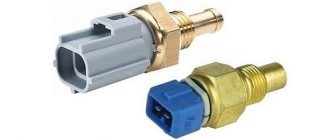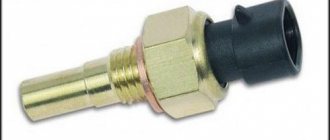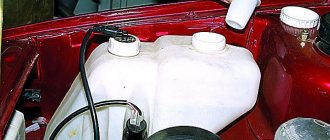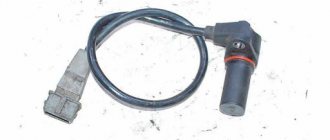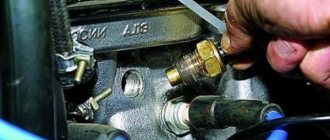28.06.2021
| (Votes: 1, Rating: 5) |
Issues discussed in the material:
- Antifreeze level sensor tasks
- Operating principle of the antifreeze level sensor
- Checking the antifreeze level
- Signs of a malfunctioning antifreeze level sensor
- Replacing the coolant level sensor
- Opinion of car owners on the operation of the antifreeze level sensor
The antifreeze level sensor is not installed on all cars, but it is a very useful monitoring device. If before starting the engine, in a parking lot, it is easy to check the coolant level by lifting the hood and looking at the expansion tank, then this will not work when driving.
Unfortunately, on some brands of cars this sensor often “acts up”, so it is necessary to periodically check its performance. From our material you will learn on what principle the coolant level sensor works, how to find out that it is faulty and replace it if necessary.
Antifreeze level sensor tasks
Even if you do not have much experience in owning a car and the vehicle was purchased not so long ago, you probably know that the engine is the most important part of it. Without an internal combustion engine, a car cannot move. Since the operation of the engine involves flammable substances, a huge amount of thermal energy is released. When fuel burns, heat appears, which has a negative effect on engine elements and leads to their breakdown.
To prevent the internal combustion engine from overheating, closed cooling systems are used; they are made in the form of connected pipes and channels. A special liquid constantly circulates through such a system, it takes thermal energy from the engine and is cooled in the radiator. The antifreeze then enters the engine again, and the cooling cycle is repeated many times while the engine is running.
To prevent pressure from increasing in the cooling system, an expansion tank is installed. As soon as the temperature of the antifreeze increases, the gas formed due to the high pressure is removed through a special hole in the expansion tank.
It is also necessary in order to control the amount of coolant, since the antifreeze level sensor is located in the expansion tank.
Next, let's take a closer look at what this element is, since it performs a very important function. Using this sensor you can monitor the coolant level in the expansion tank.
A reed antifreeze level sensor is most often installed. It is designed as an improved float device with a mechanical switch. This level gauge is budget-friendly, it has a simple design, it rarely fails and provides the ability to monitor changes in the antifreeze level over a wide range.
Reed level gauges are divided into many types. In the simplest of them, the mechanical switch of the float sensor is replaced with a reed switch, this is done to make the device more reliable. However, in most cases, a circuit with several reed switches and a float with magnets is used.
For greater clarity, let’s consider the construction that occurs most often. The sensor is made in the form of a tube; the float moves easily along it. The tube contains reed switches, the number of which can be more or less, depending on the requirements for measurement discreteness.
Different materials are used to make the housing of reed sensors; plastic products are the cheapest. Models with increased strength are more expensive and are made of stainless alloys. To choose the right product, consider the location where the sensor will be located, as well as the requirements for mechanical strength and reliability.
How to change the coolant sensor
1. Open the hood and disconnect the battery terminal.
2. Remove the plug with wires from the external connector of the sensor and unscrew the sensor.
Many manuals suggest draining the coolant. This operation is not necessary since this action does not in any way affect the element replacement process. That is why draining the coolant is impractical and only increases the work time.
3. Install the new sensor and tighten its mounting cover. Connect the plug with wires to its connector.
4. Connect the battery terminal.
This completes the replacement of the coolant level sensor. As you noticed, this is not a complicated procedure at all and is performed without the help of car service specialists.
Source
Operating principle of the antifreeze level sensor
The antifreeze level sensor functions simply, which is why it is reliable.
There is a winding inside the device, it forms an electromagnetic field. There is a float (round magnet) around it; it changes the resistance at the output of the winding. This design is called a “reed switch”. The main control unit monitors the performance of this sensor and changes the data depending on the winding resistance. As a result, it is possible to accurately control the level of antifreeze in the cooling system.
The antifreeze level sensor is located in the expansion tank, most often at the bottom of the container. Therefore, if the coolant exceeds the float threshold, the sensor will signal to the control unit that the level has a positive tolerance.
When the level of antifreeze in the expansion tank is lowered or increased, the magnetic field will change, the spring contacts will touch and the electrical circuit will be closed.
If the antifreeze level decreases, the magnetic field strength of the reed switch will drop, and thanks to the springs, the contacts will take their original position. That is, when the coolant level changes, the contacts close. In an electrical circuit they perform several functions:
- switch;
- close;
- open.
No matter what function is implemented, the circuit is triggered, causing the indicator on the dashboard to light up. On modern cars, the light comes on when the antifreeze level sensor signals that there is insufficient coolant: the contacts open and the lamp circuit turns on. When the contacts touch, the circuit is switched off and the indicator goes off.
When the volume of antifreeze in the tank is insufficient (below the float), the sensor changes resistance. This causes the electronic control unit to signal to the motorist that the coolant level is too low and that coolant needs to be added as soon as possible. This scheme of operation of the antifreeze level sensor is most often used.
General position
It's no secret that the engine in any car is the main part of its design. When creating the car, engineers took into account all the necessary points related to ensuring the safety and reliability of all transport elements.
One of the important features of the entire design is the coolant level sensor.
Thanks to this part, reliable control of the required amount of antifreeze in the expander system is ensured. The operating principle of this part is quite simple, since simplicity of design is the key to reliability.
Checking the antifreeze level
Experienced drivers always double-check the readings of the antifreeze level sensor. To do this, they inspect the expansion tank. If the engine is cold, the coolant level should be between the maximum and minimum marks. When the engine is running and warm, the coolant level may be slightly higher.
If you are driving a car and the refrigerant level has dropped sharply due to a leak, you will not be able to find out about this by inspecting the expansion tank: it is impossible to stop every 15 minutes and look into the engine compartment.
We recommend
“Antifreeze is leaving the expansion tank: causes and diagnostics” Read more
Therefore, an antifreeze level sensor is needed, the readings of which should be guided by.
If a leak forms and the refrigerant leaks out, or when the antifreeze level drops below the min mark, the sensor signals this. You will see a flashing indicator on the instrument panel. In this case, you should immediately stop driving, park the car and inspect the expansion tank to find out the cause of the breakdown. The antifreeze level sensor allows you to quickly determine that there is a malfunction and prevent the engine from overheating.
It is recommended to check the antifreeze level in the morning when the engine is not running, since the coolant expands. In addition, you should check the electrical contacts on the diagram coming to the sensor. In most cases, damage occurs to the wiring leading to the sensor, which monitors the refrigerant level.
Signs of a malfunctioning antifreeze level sensor
Due to the fact that the car has an antifreeze level sensor, drivers do not need to constantly check the amount of coolant in the expansion tank. However, this device sometimes breaks down, what to do in such a situation?
No one can predict when the sensor will break. If you have a used car, you cannot completely trust the readings of this device.
When the antifreeze level sensor is faulty, the worst thing can happen: the engine will overheat. To prevent such serious damage, monitor the condition of the sensor.
It is important to change the sensor regularly, depending on how actively you use the machine. Replacement should be made before the sensor becomes completely faulty. This way you will protect the internal combustion engine from overheating, preventing major repairs. In addition, you will not need to constantly inspect the expansion tank.
You can understand that the reed switch has failed in a situation where the refrigerant level is below the required level, but the indicator does not light up. In rare situations, this happens because the light bulb has burned out or the wiring has failed, but the sensor itself is working. But when the listed items are in order, it indicates that it is time to replace the reed switch.
Why does the temperature light on the car panel light up?
Not so long ago, cars were designed quite simply. Look at the dashboards of any old car - speedometer, tachometer and a couple of indicators. But everything is changing. Machines are becoming more and more advanced in technical terms. Accordingly, the dashboard becomes more complicated. It became difficult to figure it out on my own. And salespeople at a car dealership often skimp on their responsibilities. They say, you don’t need to pay attention to these icons, they’re lit and leave it to yourself. But that's not true.
If the temperature sensor is on, you should immediately pay attention to it.
Indicators signal dangerous changes in vehicle operating parameters. Therefore, the motorist must not only know why the engine temperature light is on, but also be able to take the necessary measures.
Your temperature indicator lights up
This light comes on when you turn on the ignition. This is fine. But a few seconds after the engine starts running, it should go out. If it continues to light, the coolant level in the cooling system is too low or there is a malfunction in the system itself. It happens that the indicator lights up directly while driving. This again may be a consequence of a lack of antifreeze. Another option is that the cooling system can no longer cope with the increase in the temperature of the unit.
It is worth noting that the color indication of different brands of cars may vary greatly. For example, blue indicates a low engine temperature, and red indicates a high temperature. You can learn about these subtleties from the operating instructions for a particular car.
Why is engine temperature so important?
The internal combustion engine, which is installed in modern cars, is not the simplest unit. It consists of a large number of both individual mechanisms and entire systems. The operation of the “iron heart” of a car is influenced by many different factors. But the temperature regime is one of the key ones.
If the temperature of the unit is less than optimal, the process of formation of the fuel mixture in the cylinders will suffer. As a result, we have a decrease in internal combustion engine power and accelerated wear. Engine overheating is even more dangerous. It leads to deformation of the cylinder head, the cooling and lubrication systems will lose their tightness. A drop in antifreeze level and increased oil consumption is not the worst option. The consequence of overheating may well be loss of elasticity of the piston rings, damage to the cylinder walls and a seized engine as the final sad result. In any case, it will not be possible to do without lengthy (and costly) repairs.
What to do
So what should you do if the temperature indicator lights up? First of all, you must immediately turn on the heating system (this will remove some of the heat from the unit). Calmly, without sudden acceleration, choose a quiet place and stop. Before turning off the engine, you need to open the hood and make sure the fan is working to cool the radiator.
The temperature lamp may be on due to a faulty thermostat.
Now you can turn off the ignition. Touch the radiator. Cold? Most likely the thermostat has failed. Does your hand feel warm? The radiator silted up or the pump “flew”. Don't forget to check the drive belt tension.
Take a break - the internal combustion engine should cool down. If you open a hot engine, you risk being burned by steam from the radiator neck. A sign of sufficient cooling will be the restoration of softness of the water pipes. Now you can open the radiator and bring the coolant level to normal. You cannot add antifreeze to a hot engine! The block head may crack.
Now slowly, without pressing the gas pedal too hard, drive to the garage. It is better to drop off fellow travelers, if any.
If the temperature sensor is on, do not accelerate too much.
So, if the engine temperature indicator lights up, you need to:
turn on the heating; stay; check the fan with the engine running; shut down the unit; estimate the temperature of the radiator; check the tension of the drive belt; wait until the engine cools down; add coolant; Drive carefully to the garage. https://www.youtube.com/embed/xW-UeQKWXmQ
https://youtube.com/watch?v=xW-UeQKWXmQ
Summarize
A lit engine temperature light indicates a serious problem. Ignoring this signal will lead to serious damage to the vehicle and very expensive repairs.
Replacing the coolant level sensor
In most cases, it will not be possible to repair or restore the antifreeze level sensor. The fact is that during the production of this device the body is made airtight, it is cast in special molds. It is impossible to disassemble and reassemble such an element. However, the price of a new part is small, so it is easier not to repair the sensor, but simply replace it.
When you do not have the opportunity to visit a service station, and the antifreeze level sensor is broken, you can replace it yourself, even if you have no experience in carrying out this type of work. The algorithm of actions is as follows:
- remove coolant from the expansion tank;
- remove the air filter;
- We take the sensor out of the rubber cover.
Then, instead of it, we install a working reed switch, focusing on the markings located on the body of the sealed switch. To do this job, you will need a 21 wrench; it is suitable for almost all models of sensors.
DIY coolant level indicator
It’s unlikely that it would ever occur to anyone to screw up the engine of their car. Agree, it’s not at all difficult to disable an engine; there are more than enough ways. A classic is considered to be engine failure due to imperceptible loss of coolant from the cooling system . It is for this reason that most modern cars are equipped not only with a coolant temperature , but also with a coolant level sensor. However, this solution to the problem is a salvation for those who bought a new car, but what about those whose car is deprived of such a useful missing “bell”? In my article today, I will tell you how to make a sensor with your own hands that would monitor the coolant level.
I tested my invention on my VAZ-2104.
The principle of the invention is that when the antifreeze level drops sharply, a light on the dashboard will light up.
Let me reassure you right away that you won’t have to do any super modifications.
What you will need for this:
1. Expansion tank (VAZ-2110) with a liquid level sensor;
2. Standard set of tools;
3. Modified (homemade) fastening belt.
So, let's start installing the expansion tank from the “ten” to the “four”.
The tank is somewhat different from the original “Zhiguli” tank; the “ten” tank has three fittings: two small ones on top and one larger one on the bottom. One of these holes should be plugged since you will only need two of the three. The upper hose (steam removal, black, which connects the expansion tank to the radiator filler hole) is from Oka. The photo shows a modified version of the radiator cap without a valve; the new “homemade” scheme does not provide for the presence of this valve, since its function will be performed by the expansion tank cap, which has valves.
Connect the large fitting located at the bottom of the expansion tank to the lower fitting of the radiator tank using a standard plastic hose from the car. Everything seems to be so, there is only one thing. Our radiator has plastic tanks, therefore, the cross-sections of the fittings do not fit the “tenth” expansion tank. What we have? The red hose fits normally with the lower fitting of the expansion tank, but does not fit the fitting located at the bottom of the radiator tank. At the same time, the black hose from Oka has a slightly too small cross-section for the upper radiator fitting.
Opinion of car owners on the operation of the antifreeze level sensor
1. I cleaned the contact, but nothing changed.
“I rode 25 kilometers, and the message “Coolant Level Low” popped up on the dashboard, meaning that the refrigerant level was insufficient. The indicator also started to light up, indicating that the motor was overheating. I immediately parked the car, checked the expansion tank, there was enough antifreeze. I continued driving, and throughout the entire trip the inscription disappeared and then reappeared.
The next day I added coolant to the maximum level. I drove 25 kilometers again, and the situation repeated itself as yesterday: the indicators are flashing, but there is enough coolant in the expansion tank.
I removed the sensor, cleaned the contact, but nothing changed. I bought a new one and installed it. Now everything is fine, no errors are displayed. I want to repair the old sensor, maybe it will work out. As for the instructions and blinking, they believe that when the indicator blinks, the coolant level is insufficient. When the motor overheats, the indicator lights up along with the “stop”, I didn’t notice what inscription appears when it overheats. My car is from 2010."
2. The electronic control unit displays errors.
“The electric pump is called the “cooling system pump”, it is located so that it can be easily inspected: at the bottom on the left side of the edge of the motor, I hope I explained it clearly.
Even after replacing the electric pump, the situation remained the same. I went to the service station again, the mechanic installed a new antifreeze level sensor. I'm currently driving the car in test mode. What they said at the car service: when the fault codes are read, an error is indicated for the electric cooling pump, so they decided to replace it. When the antifreeze level sensor fails, the failure appears on the indicator, but it is not indicated.
That is, if no errors were found when reading the codes, the mechanic would change the level sensor. But since the cooling system pump was faulty, they decided that the reason was this part and replaced it. Now everything works without problems. I believe that the malfunction occurred due to the sensor, but the electric pump of the cooling system was also added to this breakdown.”
How to check the device for serviceability
Insufficient coolant level sensor in the expansion tank - check and replacement
So, you have noticed that your engine often gets very hot, or other negative signs associated with the cooling device have been discovered. To begin with, you should check this device, and there are two ways, which we will take a closer look at.
The first option is to remove the device
- With the engine running, check the readings shown on the instruments. If the arrow is at the maximum height, then the engine is still in a cold state. Here you should break the contacts on the device and look: if the arrow points down, then it’s time to replace the coolant temperature sensor of your car.
- When the pointer remains in the same place, try to examine the system contacts; a short circuit often occurs in them. Then the problem can be fixed much faster.
- Another type of failure: the engine heats up evenly, and the instrument needle begins to jump in one direction or another. There is a high probability that the issue is with fuses that are inoperative.
- If the fuses are working, it is necessary to close the contact to ground, and again, if the arrow sharply goes up, you can safely state that there is a malfunction in the operation of the DTOZH.
Second option
- You need to take a multimeter and turn it on in resistance mode.
- Then arm yourself with a thermometer that has notches above one hundred degrees Celsius.
- Take a durable container that will not deform when the coolant is heated to a high temperature.
- After that, you need to connect the probes of the device to the sensor.
- Having made the necessary connections, the DTOZH is placed in a prepared heat-resistant container and heated.
- Here you should monitor the performance of two devices at once.
Below is the data by which you can determine the health of the sensor. The method allows you to check a new device before installing it in place of a faulty device.
The first indicators are temperature C, the second indicate resistance in Ohms.
- 30 – 1350-1880
- 50 – 585-820
- 70 – 280-390
- 90 — 155-196
- 110 — 87-109

